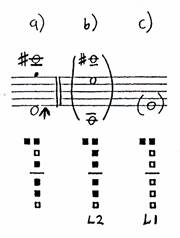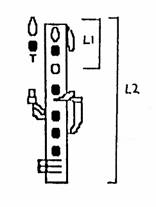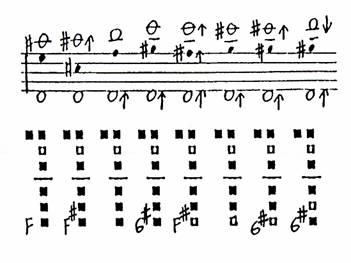| The Clarinet of the Twenty-First Century - E. Michael Richards |
CHAPTER 3 - Multiple Sounds
Some acoustical principles of clarinet multiple sounds
The general acoustic principles of the clarinet have been previously discussed; our problem here is to discover how they explain the phenomenon of multiple sounds. 11 It is obvious that multiple sounds are based on partials of a fundamental pitch. However, they are not always related as odd partials of one likely fundamental. Where do these unrelated partials come from, then? The answer may be related in some way to the even partials that exist in particular clarinet spectra mentioned by Backus and others. 12 These findings are important when one considers the derivation of pitches in clarinet multiple sounds; pitches which are not logically explained as the odd-partials of a given fundamental, may actually be out-of-tune, even-partials, or partials from another fundamental.
It is clear that multiple sounds are based on partials of at least one fundamental, but why are there such drastic timbre differences between multiple sounds and between individual pitches of one multiple sound? There must be more to an explanation of the acoustics of multiphonics. Unfortunately, many terms used to describe multiple sounds are misleading and oversimplified. Early acoustical descriptions of woodwind multiphonics often refer to them as "harmonics," pertaining to partials produced according to the standard overtone series from a fundamental pitch. This is a dangerous usage, since it invites comparison to string harmonics, which consist of one pitch produced from a single fundamental. In reality, the more accurate acoustical explanation of clarinet multiphonics is much more complex and not universally agreed upon. Another misnomer is the labeling of multiphonics as "chords." Again, a comparison with string double or triple stops is not appropriate, since each multiple sound has a different texture as well as a different timbre and intensity for each of its tones.
Ronald Caravan has suggested some interesting theories in his 1974 dissertation. 13 He cautions us, however, with regard to our interpretation of numerical figures to draw conclusions about the acoustical characteristics of the clarinet. "The human variable, which must be present to produce the sounds is great....it appears that it possesses a greater latitude of variation than the margin for error would impose even in computations on as elementary a level as those made here." 14 Nevertheless, results from spectrum analyses that he conducted fuel speculation that more than one fundamental and set of overtones are present in each multiple sound. When a multiple sonority is produced, it appears that there are actually two tube lengths at work simultaneously (Example #1).
Example #1
This seems to be supported by the following example, which shows a sequence of multiphonics with a lowest pitch that changes very little from one to the next (Example #2).
Example #2
The upper pitches, however, gradually progress upwards. It is significant that the left hand fingering remains the same; it appears that the open hole (second finger, left hand) behaves as the terminating hole of the shorter tube (Caravan calls this L1). This is similar to a E3 fingering, but is slightly lower because of the additional fingers on the right hand placed over holes. The right hand fingers gradually are lifted (in a chromatic or microtonal ascending motion); these control the length of the longer tube (L2), and cause the higher pitch, and to a lesser extent the lower pitch, of the multiphonic to gradually ascend. Thus, the terminating hole of tube L1 (open hole in the left hand fingering) also functions as a register opening or vent for L2. Caravan has labelled this hole the "register-terminator hole." THE REGISTER-TERMINATOR HOLE PERFORMS TWO SIMULTANEOUS FUNCTIONS: IT TERMINATES THE SHORTER TUBE AND ACTS AS A REGISTER OPENING OR VENT FOR THE LONGER TUBE.
Obviously, since all fingerings on the clarinet with these characteristics do not produce multiple sounds with the same ease, there must be particular limitations to the register-terminator hole. Caravan believes, through a series of informal tests, that the size of the diameter of the register-terminator hole is crucial to the ease of multiphonic production. Decreasing the size of a successful register-terminator hole lessens the ease with which the hole can be made to act as the end of a length of pipe (L1); increasing the size of a successful register-terminator hole increases the ease with which this hole can act as the terminator of a length of tube, but decreases its ability to act as a register hole for the longer tube (L2). In other words, the smaller the opening of the register-terminator hole, the greater the tendency to act exclusively as a register hole, and the larger the opening, the greater the tendency to act exclusively as the effective termination of a tube length. This theory can be used to explain why multiphonics that use the conventional register key, which has a small opening, as their register-terminator hole are more difficult to produce.
Caravan has also hypothesized that the ratio between the length of tube 1 and tube 2 must also be more than 50% and less than 80% for a multiple sound to work well. However, he admits that the size of the register-terminator hole most likely effects the relative success of these ratios. The number of variables are, indeed, numerous.
With these theories in mind, the pitches of a multiple sound in Example #2 can be explained as follows:

The lowest pitch of a) is derived from tube length L1 (c). This pitch (a sharp D3) is lower than E3 because of the added fingers of the left and right hand below the register-terminator tone hole (2nd finger of the left hand). The G4 and C-sharp5 found in multiphonic a) are produced from tube length L2 (b). This tube length would normally produce the 3rd (E4) and 5th (C-sharp5) partials above its fundamental (A3). The middle pitch of multiphonic a) is a minor third higher than the normal third partial (G4 instead of E4) because of the excessive size of the terminator hole.
It has often been noted that the same multiphonic fingering will not produce the same pitches for different players, or even for the same player from one day to the next. It is true that on equipment of the same system (Boehm, for example), the precise pitch content may not be consistent; however, these are very minor variations, at least in the multiple sounds presented in this study. These inconsistencies can result from any of a variety of reasons; an unbalanced reed, an insufficiently warmed-up instrument, specific mouthpiece characteristics, or customized clarinets, are four frequent causes. More likely, however, are deficiencies found in the construction of all clarinets and/or properties of the acoustical phenomena involved. As Paul Drushler points out, the clarinet is very much out of tune in its upper register (based on upper partials). 15 As a result, fingerings must be altered to play single pitches. However, fingerings can not be changed for each pitch of a multiple sound; they, therefore tend to be out of equal-tempered tuning, very often creating acoustical beats (amplitude modulation or interference tones) which can change markedly according to the adjustment of the reed and mechanics of the instrument. In addition, the combination of sonorities in a multiple sound may often produce difference or summation tones. 16 Difference tones may only be audible if the pitches of the multiple sound are in tune and at an adequate volume. All of these acoustical phenomena may alter principle pitches, add new pitches, or appear to the ear to do either (often they change or fade in and out during the period of sustain of the multiple sound). 17 Spectrum analyses by Caravan indicate that the strengths and tunings of partials which comprise multiple sounds do not remain in a very stable relationship among one another while the sound is produced, even though the composite sound may appear to remain constant to the listener. 18 One more variable that comes into play is the fact that pitches in a multiple sound may alter because of the adjustments required of the player to produce the split sonority; this will generally lower pitches (Example #2 is a good illustration).
Caravan presents some other valuable, although more general, insights as to why certain multiphonic fingerings seem to work better than others. "Important to note is that the smaller the degree of departure from normal playing practices a multiphonic fingering requires, the more manageable it is." 19 This is logical, since the instrument has been built to deal with problems of standard performance practice. Multiphonics built from new, but technically feasible, fingerings are closer to standard performance practice than multiphonics produced from conventional fingerings through varying the oral cavity, breath pressure, and/or embouchure. Extreme flexibility of embouchure and breath, as well as flexible moutpiece and reed set-ups, have long been characteristics of jazz players. Thus, it is not surprising that many of William O. Smith's multiphonics are produced by this manner. The author supports Caravan's statement about the unpredictability of this type of multiple sound. "The problem with multiphonics produced in this way is that in most cases they require such significant adjustments on the part of the performer that they tend to be very difficult to play, tend to be quite unstable and limited in dynamic range, and may not be attainable by every performer." 20 Composers should be cautious when writing such sonorities.
for more information about multiphonic acoustics and history, click here (password required)
for information about acquiring a password, click here
| |
||
| . |

